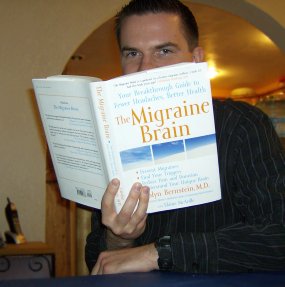The Migraine Brain: A Review
 |
One of the biggest challenges a migraineur faces is the feeling of being out of control. You don’t know where to turn next, you don’t think you can do anything to feel better – you feel like there’s no way to get out of the maze of pain you’re in.
If I could suggest a strength of The Migraine Brain by Carolyn Bernstein MD and Elaine McArdle, it would be just that – it’s an attempt to give control back to the patient, the person who wonders if there’s anything else that they can do.
After an overview of some of the most common headache types in chapter one, the authors get into the "title chapter" – how is the migraine brain different? The book addresses some of the most recent research and news about migraine.
(You’ll notice this book was one of the resources I used in my article What is Migraine? (the scientific story). Of course, you’ll read things in my article that aren’t in the book. The problem with writing things down is that they can go out of date very quickly!)
I won’t go through every chapter, but from there on the book goes on to talk about the stages of a migraine, migraine triggers and other key issues.
Then in part 2, the book gets more practical, answering questions such as:
- How can I find a doctor?
- Which medicines work?
- What about alternative treatments?
Finally in part 3, we’re guided through a "personal wellness plan" – eight steps to wellness for the migraineur.
It’s about Control
I mentioned at the beginning of this review that The Migraine Brain is all about giving control back to the migrianeur. Why? Because the book is full of practical advice on things to do – tips, lists, worksheets, and step by steps.
For example, quite a bit of space is dedicated to dealing with migraine attacks at work. First, there are 16 tips for avoiding attacks in the first place.
Next is the "Emergency Work Plan" to put into action if a migraine attack starts. Here’s what the authors suggest: notify someone at work, take a break, put your phone on voice mail and turn away from your computer screen, take your abortive medication, use an ice pack, take slow, deep breaths, use self massage (if it helps you), dim the lights and put your head down, take a short walk outside (if the attack isn’t severe), drive a caffeine drink, and if all else fails, go home (asking someone to drive you if necessary)!
Many of these things may seem obvious, but having it on paper step by step can be a great help.
Other practical features of the book include: creating a migraine travel kit, things your partner should know about migraine, 9 things to bring to your first doctor’s appointment, 14 ways to get better sleep, and making a kit of things to take to the emergency room.
A matter of Emphasis
Of course everyone has their own opinions about migraine treatment, and it’s understandable that you or I aren’t going to agree with everything in any book.
Still, at times I was surprised at the things that were emphasized in the book. There were times when it seems like a well proven treatment got very little air time, when another with little evidence of success had more.
For example, the authors spend very little time on herbs, and issue a host of warnings. They have little confidence even in well researched herbs such as feverfew.
On the other hand, there is very little warning about drugs such as topiramate (Toapamax). And there is almost as much time taken talking about "energy healing" as there is talking about all herbs for migraine put together!
The bottom line
That aside, I think this is an all-in-one book that will be valuable for people that need to make migraine treatment a significant part of their lives. (It may not be helpful for the person who has an attack a year, although they too would probably be interested to learn more about what migraine is) It really will help to put you back in the driver’s seat and make real improvements to your life.
At 333 pages, the book has a significant scope of information, and there’s something for everyone to learn. Topics such as breastfeeding, domestic violence, sex and migraine and migraine tips for partners of migraineurs are not topics you’ll find in every book on migraine! 🙂
So in spite of the book’s weaknesses, the scope of information and the truckload of tips make this, in my opinion, a welcome addition to the migraine library. It also has the advantage of being one of the newest books on the block (September 2008).
I’ll close by letting the book speak about its own goals:
You and I are going to face every aspect of your migraine disability. We’ll address each facet of your life – your family, job, healthy history, personal goals – to devise an individualized treatment approach that works for your body, your personality, and your lifestyle.
That’s the idea behind The Migraine Brain.
